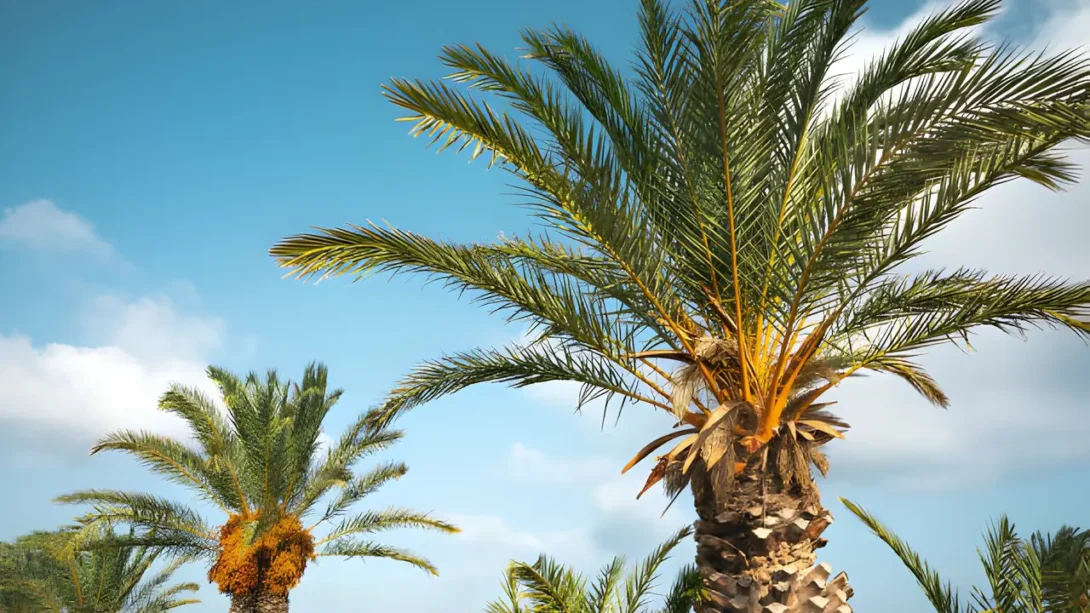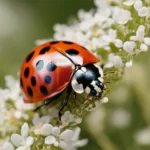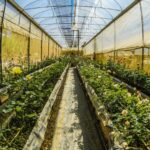The date palm tree, Phoenix dactylifera, stands as a symbol of life and prosperity in many cultures across the globe. Originating from the Middle East and North Africa, this majestic tree has been cultivated for thousands of years, not only for its sweet fruit but also for its significant role in agriculture, economy, and cultural heritage. With its towering presence and lush foliage, the date palm is a remarkable sight in arid landscapes, thriving where few other trees can.
Characteristics of the Date Palm Tree
General Appearance
Date palm trees are renowned for their tall, slender stature, often reaching heights of 15 to 25 meters (50 to 80 feet), with some specimens soaring even higher. The trunk of the date palm is unique; it’s covered in the remnants of old leaf bases, which form a distinct pattern that adds to the tree’s visual appeal. Over the years, the trunk may become quite thick, supporting the heavy crown of leaves above. These trees are not only admired for their beauty but are also celebrated for their longevity, with some living for over a century.
Leaves
The leaves of the date palm are equally impressive, growing up to 3 to 5 meters (10 to 16 feet) in length. They are pinnate, with numerous slender, pointed leaflets arranged on either side of the central stem. The color of the foliage ranges from deep green to blue-green, providing a striking contrast against arid landscapes. These leaves not only contribute to the tree’s aesthetic but also play a crucial role in its growth and fruit production, offering shade and protection for the developing dates.
Flowers and Fruits
Date palms are dioecious, meaning individual trees are either male or female. The male trees produce flowers that are small and whitish, grouped in large clusters, while the female trees bear the fruit and have similarly clustered, but slightly larger, flowers. The pollination process typically requires human intervention in cultivated settings, where pollen from male flowers is manually transferred to female trees to ensure fruit production.
The fruits themselves, known as dates, are a key feature of the date palm. They hang in large clusters from the tree and undergo a transformation in color and texture as they ripen, ranging from bright yellow or red to deep brown or amber, depending on the variety. Each date is oblong, with a sweet, rich flavor and a chewy texture, making them a cherished food item worldwide.
Varieties of Date Palm Trees
The diversity among date palm trees is vast, with over a thousand varieties cultivated around the world, each with its unique characteristics, flavors, and uses. Some of the most well-known varieties include Medjool, known for its large, sweet fruits that are often referred to as the “king of dates,” and Deglet Noor, prized for its translucent color and honey-like taste. Other notable varieties include Barhi, with its round fruits that can be eaten fresh or dried, and Khalas, celebrated for its rich flavor and tender texture. These varieties differ not only in the taste and texture of their fruit but also in their growth requirements and resistance to diseases, influencing their cultivation in different regions.
Growing Conditions and Cultivation
Date palms thrive in hot, arid climates, symbolizing resilience and the ability to prosper under challenging conditions. They prefer full sun and well-drained soil, demonstrating remarkable drought tolerance once established. However, for optimal fruit production, date palms require specific conditions, including high temperatures and minimal rainfall. These trees are often irrigated in dry regions to ensure adequate water supply throughout the fruit development stages.
Cultivation practices for date palms have been refined over centuries, focusing on maximizing fruit yield and quality. This includes the careful selection of male and female trees for pollination, a process that is frequently done by hand to ensure effective fertilization. Pruning is another essential practice, involving the removal of old leaves and thinning of fruit clusters to allow for better air circulation and sunlight penetration, which in turn promotes healthier fruit development.
The cultivation of date palms is a labor-intensive process that requires significant knowledge and skill. From selecting the right variety to ensuring proper pollination and fruit set, each step is crucial for successful date palm cultivation. These practices highlight the deep connection between the date palm and the cultures that have cultivated it for millennia, underscoring the tree’s importance not just as a source of food but also as a component of cultural heritage.
Uses and Significance
The date palm tree is much more than a source of delicious fruits; it’s a symbol of life and sustenance in arid regions, playing a pivotal role in the communities that cultivate them. Beyond fruit production, every part of the date palm has a purpose. The leaves are used for making baskets, mats, brooms, and even roofing material in traditional constructions. The trunk, once the tree ceases to bear fruit, serves as timber for building or is used to create furniture. Even the seeds have value, ground into flour or used as animal feed, showcasing the sustainability inherent in date palm cultivation.
The nutritional value of dates is remarkable, providing a significant source of energy, fiber, vitamins, and minerals. This has made them a staple food in many diets, especially in the Middle East and North Africa, where they are often eaten to break the fast during Ramadan, due to their quick energy-boosting properties.
Cultural and Economic Significance
Culturally, the date palm tree is deeply ingrained in the history and traditions of many regions. It is mentioned in religious texts, folklore, and has been a symbol of hospitality and peace in many cultures. The tree’s resilience and ability to produce fruit in harsh conditions have made it a symbol of life and prosperity amid adversity.
Economically, date palms are a vital crop in desert agriculture, contributing significantly to the livelihoods of farmers in date-producing countries. The global date fruit market is substantial, with dates being exported around the world as a cherished delicacy. This international trade not only supports local economies but also introduces the rich cultural heritage of date cultivation to a global audience.
Conclusion
The date palm tree, with its elegant stature and bountiful yield, stands as a testament to the ingenuity and resilience of those who cultivate it. From its striking appearance and sweet fruits to its versatile uses and cultural significance, the date palm is a true marvel of the plant kingdom. As we appreciate the beauty and bounty of these trees, we also recognize the important role they play in ecosystems, cultures, and economies across the globe. The date palm not only enriches our landscapes but also our lives, providing sustenance, shelter, and a bridge between generations and cultures. Its continued cultivation is a tribute to the enduring relationship between humans and the natural world, highlighting the importance of preserving these ancient traditions for future generations.



